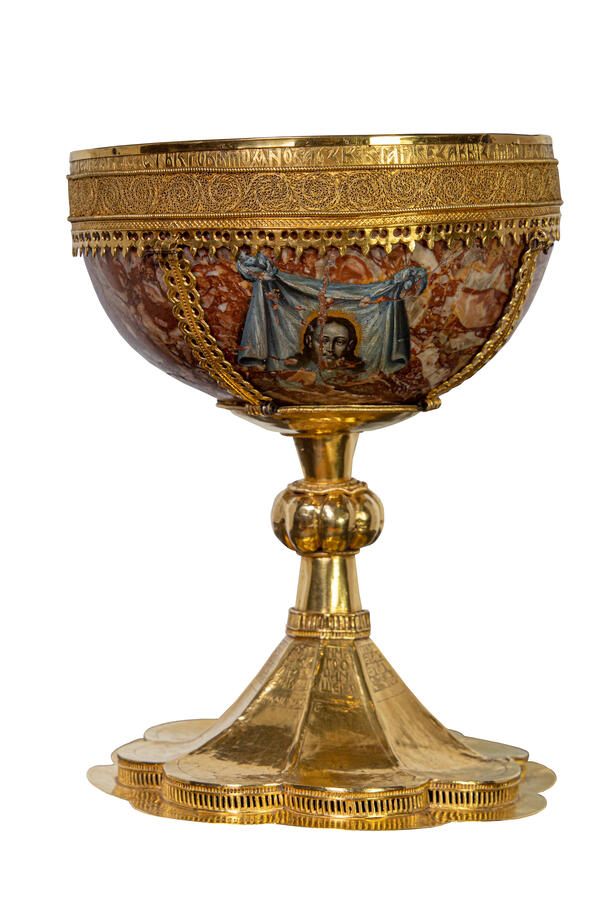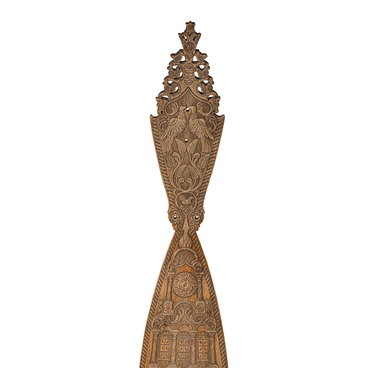A chalice is a bowl used during liturgical services. It was made for the Trinity Cathedral of the Trinity-St. Sergius Monastery by the order of the Grand Duke of Moscow Vasiliy II. This is evidenced by the carved inscription on the pallet of the vessel: “In the monastery of our reverend father Abbot Sergius, this chalice was made by the Christ-loving Grand Duke Vasiliy Vasilyevich to the church of the Holy Trinity in the summer of 6947 [1439].”
Presumably, the chalice was given with a prayer for the safe birth of a child. On January 22, 1440, the second son of Vasiliy Vasilyevich and Maria Yaroslavna, Ivan, the future Grand Duke of Moscow Ivan III, was born.
The Trinity-Sergius Monastery is associated not only with joyful events and expectations of the arrival of Vasiliy II, but also with one of the most tragic episodes of his life. In 1446, the Grand Duke tried to hide in the Trinity Cathedral of the monastery from the supporters of Dmitriy Shemyaka, who had violated the conciliatory oath. But he was captured, taken to Moscow and blinded. That is why the nickname “Dark” was added to the name of Vasiliy II.
This chalice is one of the most precious vessels that were kept in the sacristy of the Trinity Monastery, and one of the rare artefacts of Moscow jewelry art of the second quarter of the 15th century. The hemispherical bowl is made of red-yellow marble. The bloody color of the stone perfectly corresponds to the purpose of the vessel, which was used in administering the sacrament of the Eucharist — the Holy Communion, when believers “partake of the blood (wine) and flesh (church bread — prosphora) of Jesus Christ.”
The stone bowl is inserted into a gold frame, the stem and pallet of the vessel are also made of high-grade gold. The details of the decor — a strip of cutwork flowers on the lower part of the crown, openwork “ferrule” that support the bowl, cutwork columnar ornaments at the base of the stem and on the cut of the pallet — shows that the master was familiar with the works of the Western European Gothic art.
The crown of the marble bowl is decorated with a strip of the finest filigree ornament made of twisted wire. A characteristic feature of the filigree, made by Moscow masters, is the framing of the main stem with spiral curls and small loops.
The painted image of the Holy Image of the Saviour Not Made by Hands on the marble chalice dates back to the 19th century, and the inner, perfectly polished, gold bowl is also more recent.
Presumably, the chalice was given with a prayer for the safe birth of a child. On January 22, 1440, the second son of Vasiliy Vasilyevich and Maria Yaroslavna, Ivan, the future Grand Duke of Moscow Ivan III, was born.
The Trinity-Sergius Monastery is associated not only with joyful events and expectations of the arrival of Vasiliy II, but also with one of the most tragic episodes of his life. In 1446, the Grand Duke tried to hide in the Trinity Cathedral of the monastery from the supporters of Dmitriy Shemyaka, who had violated the conciliatory oath. But he was captured, taken to Moscow and blinded. That is why the nickname “Dark” was added to the name of Vasiliy II.
This chalice is one of the most precious vessels that were kept in the sacristy of the Trinity Monastery, and one of the rare artefacts of Moscow jewelry art of the second quarter of the 15th century. The hemispherical bowl is made of red-yellow marble. The bloody color of the stone perfectly corresponds to the purpose of the vessel, which was used in administering the sacrament of the Eucharist — the Holy Communion, when believers “partake of the blood (wine) and flesh (church bread — prosphora) of Jesus Christ.”
The stone bowl is inserted into a gold frame, the stem and pallet of the vessel are also made of high-grade gold. The details of the decor — a strip of cutwork flowers on the lower part of the crown, openwork “ferrule” that support the bowl, cutwork columnar ornaments at the base of the stem and on the cut of the pallet — shows that the master was familiar with the works of the Western European Gothic art.
The crown of the marble bowl is decorated with a strip of the finest filigree ornament made of twisted wire. A characteristic feature of the filigree, made by Moscow masters, is the framing of the main stem with spiral curls and small loops.
The painted image of the Holy Image of the Saviour Not Made by Hands on the marble chalice dates back to the 19th century, and the inner, perfectly polished, gold bowl is also more recent.



